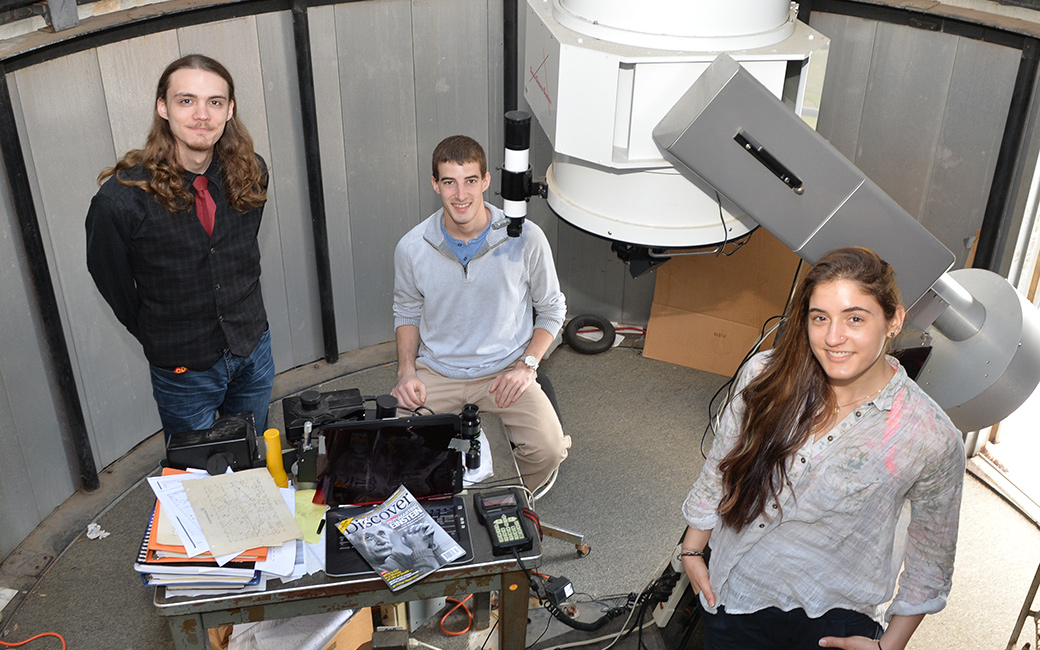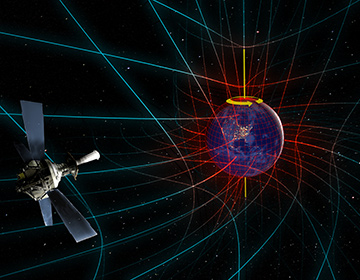Beyond Einstein
TU professor, students investigate whether Einstein can be outsmarted.

This year is the 100th anniversary of Albert Einstein’s theory of general relativity, the best theory about gravity today. But it isn’t compatible with “the Standard Model” of particle physics that governs everything else; reconciling Einstein’s ideas about curved space and time with the rest of physics to develop the elusive unified theory of the universe is physics’ ultimate prize.
Towson University’s Jess and Mildred Fisher College of Science and Mathematics physics professor James Overduin and his students, Nathan Prins, Kielan Wilcomb and Dan Zile, are among the scientists working toward the quantum leap unification may bring.
It would likely change the course of human history. Just as unifying electricity and magnetism led directly to electric motors, radio communications, and the modern power grid, reconciling general relativity and the standard model could give humans new ways to manipulate the forces of gravity.
“ The thing I love about physics is I get to investigate why the universe is the way it is, and how it does what it does... ”
Overduin, mentor to Prins, Wilcomb and Zile, began working on unification less than 10 years ago, and his enthusiasm quickly turned into a passion he shares with his students.
“To save the earth, we need revolutionary new technologies,” Overduin said. “The best way to discover those is to revolutionize fundamental physics. […S]ome of the best [students] have also become interested as well, and their enthusiasm has fed back into my own research. Some of the papers I'm proudest of have been co-authored with these students. And we have plans for many more.”
Driving Forces
Prins grew up discussing math concepts at the dinner table. That solid foundation
in the discipline was the driving force behind his desire to be a physicist.
“The thing I love about physics is I get to investigate why the universe is the way it is, and how it does what it does,” he said. “The universe is so weird and amazing. To me, just the fact that we can create a set of laws that describes the whole universe is amazing. And the results from those laws are just as amazing.”
Wilcomb’s entrance into the field was more by centrifugal force. A modern dancer for 15 years, she arrived at Towson intending to major in it. That soon changed.
“All of the physics faculty, including the head of the department, David Schaefer, were so incredibly supportive and open for questions that I almost fell in love with the department before the science,” she stated. “I take very little credit for how well I've done in physics. My fellow students, professors and parents have helped me persevere when I ran into roadblocks.”
From childhood, Zile was driven by an innate curiosity about how the world worked. That “need to know” led to many discussions with his professor and eventually his move to a physics major.
Students Making an Impact
Unification is not a job best left to professionals. Prins, Wilcomb and Zile - all undergraduates - are conducting research to contribute toward moving physics closer to a unified theory.
Prins spent the summer of 2014 at the Albert Einstein Institute in Hannover, Germany, researching gravitational waves. This summer he is researching accelerator physics at the Argonne National Laboratory and will spend two weeks at the U.S. Particle Accelerator School. Einstein’s theory predicts the accelerated expansion of the universe through dark energy; Prins’ work deals with finding new ways to describe Einstein’s dark energy.

While Wilcomb is spending her second summer at The Johns Hopkins University Applied Physics Lab, her first completed research project was with Overduin and based on her previous calling. Presented at three conferences, "When You Dance, You Dance with the Universe" explores how the centrifugal force that pulls a dancer's arms outward when she spins may actually be due to the stars and galaxies making up the rest of the universe - questions that intrigued Einstein and are described by general relativity.
Zile’s research, conducted at TU with Overduin, explores the parallels between Einstein's theory of gravity and Maxwell's theory of electromagnetism, showing that many of gravity's most paradoxical aspects can be understood in terms of undergraduate physics. They received a Faculty Development Research Committee (FDRC) grant for this work and are writing it up for publication.
“This work is still in progress, but we hope that by exploring these parallels between Einstein's and Maxwell's theories, we will gain insight into the nature of the theory that must eventually unify them with the other forces in the Standard Model,” noted Zile.
By Megan Bradshaw
Photos: Kanji Takeno